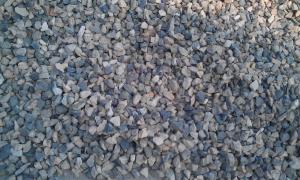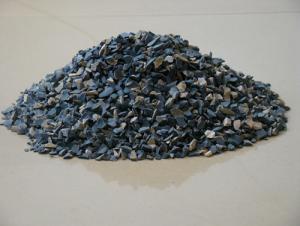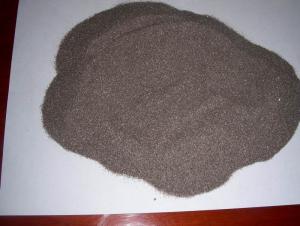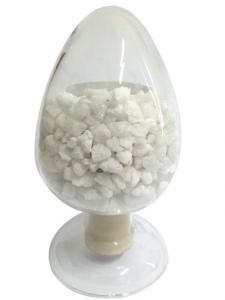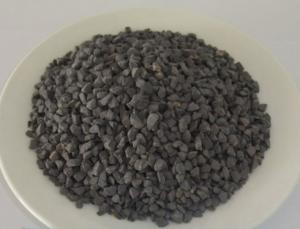Calcined Bauxite Ore Metallurgical Grade Bauxite for Cement Industry
- Loading Port:
- China main port
- Payment Terms:
- TT OR LC
- Min Order Qty:
- 25 m.t.
- Supply Capability:
- 2000 m.t./month
OKorder Service Pledge
OKorder Financial Service
You Might Also Like
Packaging & Delivery
| Packaging Details: | Net weight 25kg in a PVC bag, 1 metric ton in a jumbo bag on pellet. |
| Delivery Detail: | 50 days |
Details
China Calcined Bauxite Ore Metallurgical Grade Bauxite for Cement Industry
Bauxite is a kind of earthy minerals, the main constituent is impurity hydrated alumina. It is white or
off-white, but it will appear tawny or light red because of adding iron.
Bauxite is extremely difficult to melt. It is insoluble in water, but soluble in sulfuric acid and sodium hydroxide solution.
Technical Index
China Calcined Bauxite Ore Metallurgical Grade Bauxite for Cement Industry
Bauxite | |||||||
Item | Al2O3 % | Fe2O3 % | TiO2 % | CaO+MgO % | K2O+Na2O % | Bulk Density g/cm3 | Water Absorption % |
GAL-88 | ≥88 | ≤1.5 | ≤4.0 | ≤0.4 | ≤0.4 | ≥3.15 | ≤4 |
GAL-85 | ≥85 | ≤1.8 | ≤4.0 | ≤0.4 | ≤0.4 | ≥3.10 | ≤4 |
GAL-80 | ≥80 | ≤2.0 | ≤4.0 | ≤0.5 | ≤0.5 | ≥2.90 | ≤5 |
GAL-70 | 70-80 | ≤2.0 | -- | ≤0.6 | ≤0.6 | ≥2.75 | ≤5 |
GAL-60 | 60-70 | ≤2.0 | -- | ≤0.6 | ≤0.6 | ≥2.65 | ≤6 |
GAL-50 | 50-60 | ≤2.5 | -- | ≤0.6 | ≤0.6 | ≥2.45 | ≤6 |
Application:
Bauxite is widely apply to refractories, aluminum silicate refractory fiber, precision casting, alumina smelting industry, bauxite cement, etc.
Our Advantages:
1. The bauxite ore is competitive price.
2. High purity.
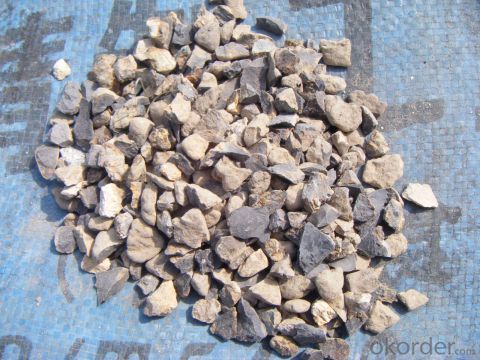
- Q:Development trend of refractory industry
- China announced that from 2004 January, the export of most refractory raw materials will be cancelled, and the export of finished products will also reduce the tax rebate rate. This means that important raw materials for further export restrictions, some developed countries dependent on imports of China's refractory materials and products of the refractories industry will have a major impact. In order to reduce costs, they will move their factories to Chinese, which is the development of Chinese refractories industry will also be an important opportunity. In addition, the convenience of communication and transportation, the change of the international market and the increase of e-commerce have also brought good opportunities to the development of refractory industry.
- Q:In entering fire door, which material does well?
- About this, I personally advice you to take a look at the building materials market, where will be many options and comparativity would be much better.
- Q:Who knows the fire rating of fire?partition with steel stud?
- Cement board wall of steel stud: it is used for walls with ceramic in kitchens, restroom, disinfect room, etc. If single-sided tile is made, cement pressure plate can be used on one side. Gypsum board is used on the other side. Fire?rating is A1. CaSo4.2H2O is molecular structural formula of gypsum which contains 20% water, crystal water and free water. When 10% water slowly evaporates on the flame surface, there is still 10% crystal water. Itself is grade A fire retardant material. 1 hour. It is in line with the fireproof test standard of national building materials. It can reach up to 4 hours at most.
- Q:How to divide the fire resistant level of construction thermal insulation materials?
- 1, Combustion performance of the national standard building materials are divided into the following levels: Class A: incombustible building material: Material that almost never burn. Class B1: nonflammable building material: Nonflammable materials have good effect of flame resistance. In case of fire it in the air or at high temperature it is difficult to catch fire and spread, and when the fire source is removed, the combustion can stop immediately. Class B2: combustible?building?material: Combustible materials have good effect of flame resistance. In case of open fire in the air or at high temperature, it will immediately burst into flames and spread the fire quickly, such as wooden column, timber roof truss, wooden stairs, etc. Class B3: flammable building material: No flame-retardant effect, highly flammable, high risk of fire. 2, According to fire?rating, external wall thermal insulation materials can be divided into 1) thermal insulation material with class A combustion performance. Rock wool, glass wool, foam glass, foamed ceramics, foam cement, hole-closed perlite,etc. 2) thermal insulation material with class B1 combustion performance: Extruded polystyrene board (XPS) after special treatment /polyurethane (PU) after special treatment , phenolic aldehyde, gelatine powder polyphenyl granule, etc. 3) thermal insulation material with class B2 combustion performance: Molding polystyrene board (EPS), extruded polystyrene board (XPS), polyurethane (PU), polyethylene (PE), etc.
- Q:What refractories are accessible with ease in daily life?
- Refractory mortar. Thermal insulation refractory materials include diatomite products, refractory castables, monolithic?refractories, carborundum bricks, gun-mix refractories, semi-silica bricks, borides, beryllia, silicide, calcium oxide, high alumina refractory brick, refractory coatings, corundum bricks, fireclay?bricks, silicon nitride bonded silicon carbide bricks, chromium hemitrioxide and other refractories. What refractories can be found mostly in the market? Common refractories. Common refractories include silica bricks. The mostly used unshaped refractories include fettling, ramming refractories, castable refractories, plastic refractories, refractory clay, gun-mix refractory, sling refractories, refractory coatings, lightweight refractory castables, stemming etc. The mostly used insulating refractories include diatomite products, asbestos products, insulation panels, etc. The mostly used special refractories include AZS bricks.
- Q:Is there requirement for radiation indicator in refractory?
- All refractories have no radiated harm to environment, so there is no requirement. From the elemental analysis, magnesite. I do not know it is helpful to you. But for refractory rwa material, any chemical element is radiated, including silicon?dioxide; If they are radioactive. From the use analysis, such as bauxite, do not have use value.
- Q:I wanna ask what are the acidic refractories?
- Usually, acidic refractory refers to a kind of refractory which contains a amount of silicon?dioxide. There are the following: (1) silica?brick with stronge acidity, unshaped silicious refractory, quartz glass and fused silica combined products; (2) semi-silica refractory with moderate acidity and pyrophyllite refractory; (3) clay-based refractory with weak acidity. The main features of the acidic refractories is resistant to the erosion of acidic substances (acidic residue) in high temperature, but is easy to react with alkaline material (basic slag). zirconite fireproofing material and silicon carbide as the special acidic refractories refractories are also in this category.
- Q:Which are fire proofing thermal insulation materials?
- Which are fire proofing thermal insulation materials? Which fire proofing thermal insulation materials are commonly seen?
- Q:hat kind of fire retardant materials are there
- At present, there are mainly organic and inorganic flame retardant materials, halogen and non halogen. Organic flame retardant materials are represented by bromine, nitrogen and phosphorus and its compounds; Inorganic fire retardant materials include antimonous oxide, magnesium hydroxide, aluminum hydroxide, and silicon. Generally speaking, organic flame retardant materials have a good affinity, and can be added in the plastics. Brominated flame retardant agent occupy the absolute advantage among organic flame retardant system, though it’s “controversial” in terms of environmental protection, it has been difficult to have other flame retardant system replaced.
- Q:What are the materials of insulation firebricks?
- The raw materials of firebricks, firebricks have various raw materials, and the composition of which can be divided into six categories: soil, stone, sand, mineral, powder and others. One of the raw materials, soil: bauxite, kaoline, clay, diatomite Another raw material, stone: fluorite, kyanite, andalusite, forsterite, vermiculite, mullite, pyrophyllite, chlorite, dolomite, sillimanite, magnesia-alumina spinel, and silica Another raw material, sand: clay sand, zircon sand, quartz sand, and magnesite Another raw materials, mineral: chromium mineral Another raw material, powder: aluminum powder, micro-silica powder, and silicon powder Another raw materials, others: asphalt, graphite, phenolic resin, perlite, cenosphere, sialon, corundum, silicon sulfate, silicon carbide, sodium silicate, silica sol, boron carbide, calcium aluminate cement, nitride material, haydite, aluminum oxide, alumina sol and zirconia, etc.
1. Manufacturer Overview |
|
|---|---|
| Location | |
| Year Established | |
| Annual Output Value | |
| Main Markets | |
| Company Certifications | |
2. Manufacturer Certificates |
|
|---|---|
| a) Certification Name | |
| Range | |
| Reference | |
| Validity Period | |
3. Manufacturer Capability |
|
|---|---|
| a)Trade Capacity | |
| Nearest Port | |
| Export Percentage | |
| No.of Employees in Trade Department | |
| Language Spoken: | |
| b)Factory Information | |
| Factory Size: | |
| No. of Production Lines | |
| Contract Manufacturing | |
| Product Price Range | |
Send your message to us
Calcined Bauxite Ore Metallurgical Grade Bauxite for Cement Industry
- Loading Port:
- China main port
- Payment Terms:
- TT OR LC
- Min Order Qty:
- 25 m.t.
- Supply Capability:
- 2000 m.t./month
OKorder Service Pledge
OKorder Financial Service
Similar products
New products
Hot products
Related keywords
